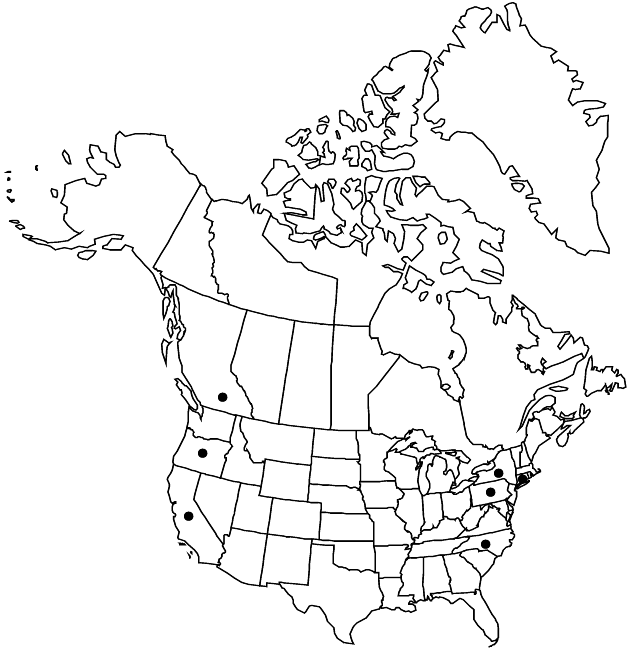Difference between revisions of "Crepis vesicaria"
Sp. Pl. 2: 805. 1753.
FNA>Volume Importer |
imported>Volume Importer |
||
| (3 intermediate revisions by 2 users not shown) | |||
| Line 8: | Line 8: | ||
}} | }} | ||
|common_names=Beaked or weedy hawksbeard | |common_names=Beaked or weedy hawksbeard | ||
| + | |special_status={{Treatment/ID/Special_status | ||
| + | |code=I | ||
| + | |label=Introduced | ||
| + | }} | ||
|basionyms= | |basionyms= | ||
|synonyms= | |synonyms= | ||
| Line 24: | Line 28: | ||
|elevation=0–300 m | |elevation=0–300 m | ||
|distribution=B.C.;Calif.;Conn.;N.Y.;N.C.;Oreg.;Pa.;Europe;introduced;South America. | |distribution=B.C.;Calif.;Conn.;N.Y.;N.C.;Oreg.;Pa.;Europe;introduced;South America. | ||
| + | |introduced=true | ||
|discussion=<p>Native to the Mediterranean region of western Europe, <i>Crepis vesicaria</i> is recognized by its annual or biennial habit, pinnately lobed leaves, reflexed calyculi, tomentose and glandular phyllaries, and slender, long-beaked inner cypselae. It is polymorphic; subspecies are recognized in Europe. E. B. Babcock (1947) identified the North American plants as subsp. taraxaciflora (Thuiller) Thellung, which some Europeans (T. G. Tutin et al. 1964–1980, vol. 4) have listed as a synonym of subsp. haenseleri (Boissier ex de Candolle) P. D. Sell.</p> | |discussion=<p>Native to the Mediterranean region of western Europe, <i>Crepis vesicaria</i> is recognized by its annual or biennial habit, pinnately lobed leaves, reflexed calyculi, tomentose and glandular phyllaries, and slender, long-beaked inner cypselae. It is polymorphic; subspecies are recognized in Europe. E. B. Babcock (1947) identified the North American plants as subsp. taraxaciflora (Thuiller) Thellung, which some Europeans (T. G. Tutin et al. 1964–1980, vol. 4) have listed as a synonym of subsp. haenseleri (Boissier ex de Candolle) P. D. Sell.</p> | ||
|tables= | |tables= | ||
| Line 33: | Line 38: | ||
-->{{#Taxon: | -->{{#Taxon: | ||
name=Crepis vesicaria | name=Crepis vesicaria | ||
| − | |||
|authority=Linnaeus | |authority=Linnaeus | ||
|rank=species | |rank=species | ||
| Line 48: | Line 52: | ||
|publication title=Sp. Pl. | |publication title=Sp. Pl. | ||
|publication year=1753 | |publication year=1753 | ||
| − | |special status= | + | |special status=Introduced |
| − | |source xml=https:// | + | |source xml=https://bitbucket.org/aafc-mbb/fna-data-curation/src/2e0870ddd59836b60bcf96646a41e87ea5a5943a/coarse_grained_fna_xml/V19-20-21/V19_315.xml |
|tribe=Asteraceae tribe Cichorieae | |tribe=Asteraceae tribe Cichorieae | ||
|genus=Crepis | |genus=Crepis | ||
Latest revision as of 19:51, 5 November 2020
Annuals, biennials, or perennials, 3–120 cm (taproots slender to thick, caudices swollen). Stems 1, erect to arcuate or decumbent (green or purple proximally), usually much branched, glabrate to hispid and/or tomentose, sometimes sparsely setose (setae black). Leaves basal and cauline; petiolate (bases clasping); blades oblanceolate to ovate, often runcinate, 10–35 × 2–8 cm, margins pinnately lobed to toothed (terminal lobes relatively large), apices obtuse or acute, faces usually hirsute (hairs sometimes only on veins) or glabrous (cauline sessile, bases auriculate, clasping, margins ± toothed). Heads 10–20, in lax, corymbiform arrays. Calyculi of 5–12, ovate to linear-lanceolate, glabrous bractlets 3–4 mm (reflexed in fruit, scarious). Involucres cylindro-campanulate (becoming turbinate or urceolate in fruit), 5–14 × 5–6 mm. Phyllaries 7–16, (reflexed at maturity) lanceolate, 10–12 mm, (margins green to yellowish), apices obtuse or acute (ciliate), abaxial faces tomentose and often stipitate-glandular, adaxial with fine, appressed hairs. Florets 50–70; corollas yellow (reddish abaxially), 6–15 mm. Cypselae (monomorphic or dimorphic) pale brown or yellowish, fusiform, 4–9 mm, outer wider with apices attenuate (not beaked), inner gradually tapered, beaked (beaks 2–5 mm, ± equal to bodies), ribs 10 (narrow); pappi white (fine, soft), 3–6 mm. 2n = 8, 16.
Phenology: Flowering Feb–Oct.
Habitat: Sandy clearings, hillsides
Elevation: 0–300 m
Distribution

Introduced; B.C., Calif., Conn., N.Y., N.C., Oreg., Pa., Europe, introduced, South America.
Discussion
Native to the Mediterranean region of western Europe, Crepis vesicaria is recognized by its annual or biennial habit, pinnately lobed leaves, reflexed calyculi, tomentose and glandular phyllaries, and slender, long-beaked inner cypselae. It is polymorphic; subspecies are recognized in Europe. E. B. Babcock (1947) identified the North American plants as subsp. taraxaciflora (Thuiller) Thellung, which some Europeans (T. G. Tutin et al. 1964–1980, vol. 4) have listed as a synonym of subsp. haenseleri (Boissier ex de Candolle) P. D. Sell.
Selected References
None.